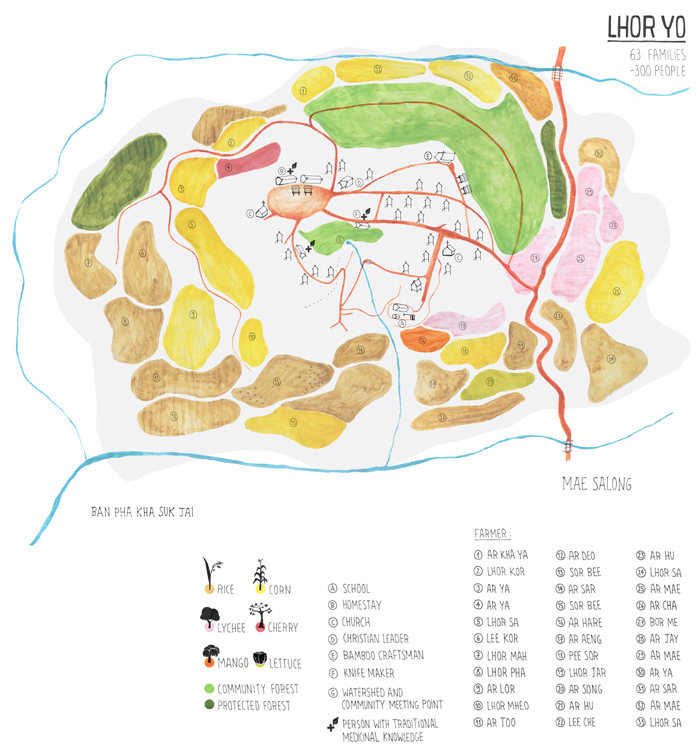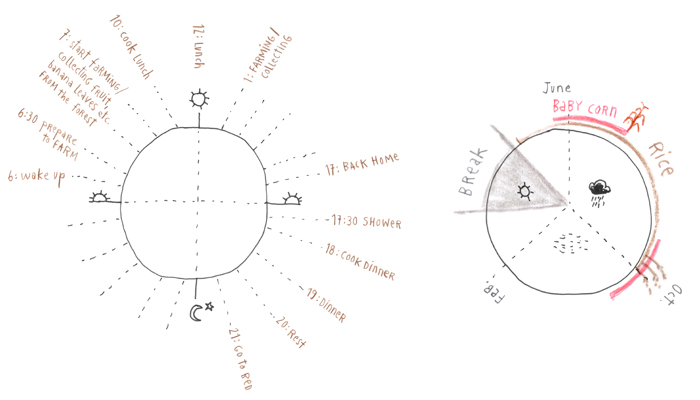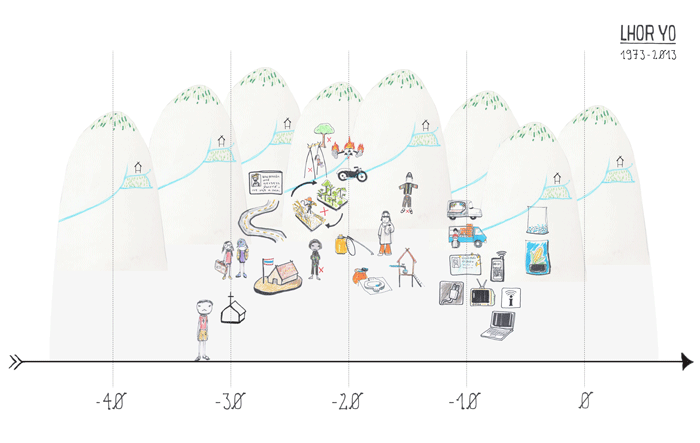
 This map of Lhor Yo was created by walking the village and drawing the knowledge of locals.
People's houses are typically placed in the centre of an Akha settlement, surrounded first by the community forest and personal gardens.
There, a mix of fruit trees, vegetables, coffee, herbs, bamboo and other trees are grown.
Villagers can collect food and resources in the community forest as they need.
The use of these forests is specified in agreements with the forest department.
This map of Lhor Yo was created by walking the village and drawing the knowledge of locals.
People's houses are typically placed in the centre of an Akha settlement, surrounded first by the community forest and personal gardens.
There, a mix of fruit trees, vegetables, coffee, herbs, bamboo and other trees are grown.
Villagers can collect food and resources in the community forest as they need.
The use of these forests is specified in agreements with the forest department.
The fields form the following ring around the village, stretching often down steep slopes. Farmers here grow mostly rice for personal consumption (brown), and baby corn and sweet corn (yellow), which in the recent years has become a commodity crop for contract farming. Lychee trees (light pink) are a main fruit tree which is also used for fire wood. Each family has their own fields, but during harvest season families help each other cutting and gathering the crop.
Around many villages on higher altitudes, watershed forests are located which are protected by the national government (dark green). These forests cannot be used or cultivated by the locals.
Locations indicated in the village: school, churches (catholic and protestant), home-stay, homes of experts in herbal medicine, basket and knife making.

 The first cycle describes the general rhythm of daily farming practice.
It shows that most of the day is spent with the production, collection and preparation of food.
For other activities there remains only little time after sunset, such as further education, time with the family or doing craftwork.
The first cycle describes the general rhythm of daily farming practice.
It shows that most of the day is spent with the production, collection and preparation of food.
For other activities there remains only little time after sunset, such as further education, time with the family or doing craftwork.
The second cycle indicates farming practice throughout the year, which is divided into three seasons: hot, rainy, and cool dry periods. During the hottest period in the summer there is the least farming activity. The seed time starts just before the rainy season. Rice is harvested once in the beginning of the cool season, corn is planted two times per year.

 Together with the people of Lhor Yo we created this timeline for their village.
The first families settled about 70 years ago, a second group of families joined about 30 years ago, mostly migrating there from Burma.
Many changes in the village happened around that time as well, with the introduction of Christianity and the launch of governmental programmes.
Together with the people of Lhor Yo we created this timeline for their village.
The first families settled about 70 years ago, a second group of families joined about 30 years ago, mostly migrating there from Burma.
Many changes in the village happened around that time as well, with the introduction of Christianity and the launch of governmental programmes.
Together with new products, also new words entered the language of the Akha. Words such as bin, garbage, corn, company, fertiliser are taken from the Thai language.




